This blog post has been revamped and updated for the latest 2023-2027 English study design.
Contents
1. What Is Language Analysis?
2. What Are You Expected To Cover? (Language Analysis Criteria)
3. School Assessed Coursework (SAC), Exams, and Allocated Marks
4. How To Prepare for Your Language Analysis SAC and Exam
5. How To Write a Language Analysis
1. What Is Language Analysis?
Language Analysis is officially known as ‘Exploring Argument’ in Year 11, and ‘Analysing Argument’ in Year 12 (your teachers might also refer to it as ‘Argument Analysis’). We’ll use the term Language Analysis throughout this blog to keep things simple.
Like its name suggests, in Language Analysis, you will read, view and/or listen to a range of short, persuasive texts, and then you’ll analyse the way the author has used persuasive language devices to construct their argument. You’ll be analysing written texts, like opinion pieces or newspaper articles, and audio or audio-visual texts, like podcasts or speeches. Your job is to unpack the contention the author has put forward to their audience, understand their purpose, and break down the methods they’ve used to persuade their audience of their perspective - then, you’ll express all of these ideas in an essay.
In your Language Analysis SAC(s), you will be expected to analyse at least one written text and at least one audio or audio-visual text. Your teacher might give you the texts to study in advance, or you might be asked to read and analyse cold material on the day (meaning you won’t have seen the text before your SAC).
Language Analysis is also one of the three components of the VCE English exam. You’ll only have one written text to analyse in the exam, but it will contain embedded images! You will be asked to analyse cold material, so that all students go into the final exams on equal footing.
NOTE: The ‘Exploring Argument’ and ‘Analysing Argument’ Areas of Study (aka Language Analysis) also include the Oral Presentation, but we cover that separately in our Ultimate Guide to Oral Presentation.
Let's get into it!
2. School Assessed Coursework (SAC), Exams and Allocated Marks
In Years 11 and 12, you’ll most likely tackle Language Analysis in Term 4 - your school may do it at a different time though, so double check with your teacher.
Since your Year 11 results don’t count towards your final Study Score, below is a breakdown of the marks allocated to your Language Analysis SAC in Year 12:
- Unit 4 English: 40 marks
- Unit 4 EAL: 40 marks
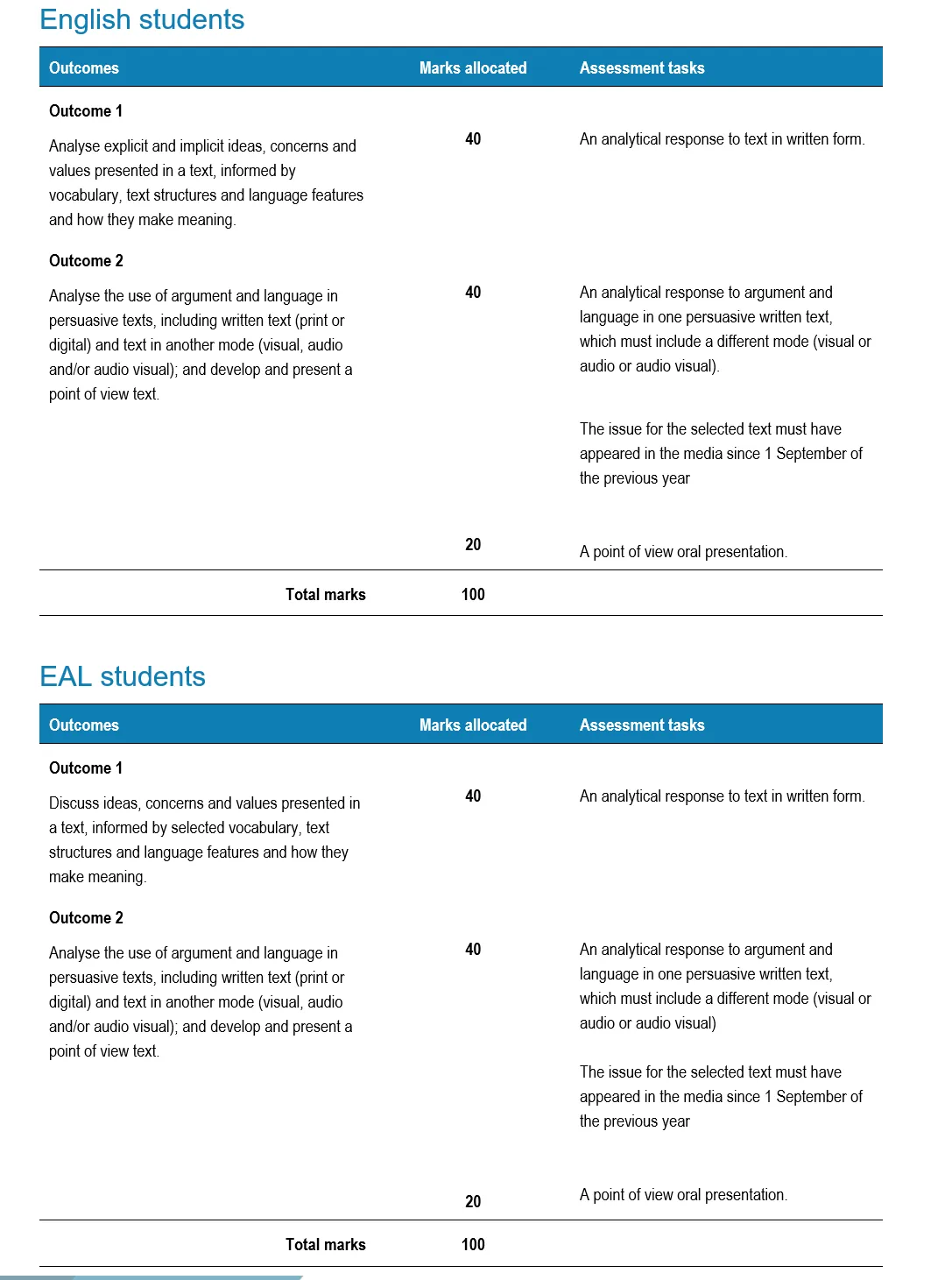
This means that 40% of your School Assessed Score for Unit 4 comes from your Language Analysis SAC.
The time allocated to your SAC is school-dependent. Often, schools use one or two class periods to conduct your SAC, depending on how long each of your periods lasts. VCAA suggests you write between 700 to 900 words for your Language Analysis. Keep in mind that it’s about quality, not quantity, and for anything internally marked, it’s important to keep your teacher’s preferences in mind!
In your exam, you get a whopping total of 3 hours to write 3 responses (Text Response, Creative and Language Analysis). The general suggestion is to spend 60 minutes on Language Analysis, but it is up to you exactly how much time you decide to dedicate to this section of the exam. Each section of the exam is worth a total of 20 marks.
3. What Are You Expected To Cover? (Language Analysis Criteria)
What are teachers and examiners expecting to see in your essays? Below are the VCE criteria for Language Analysis essays.
NOTE: Some schools may express the following points differently; however, they should all boil down to the same points - what is necessary in a Language Analysis essay.
a) Understanding of the argument(s) presented and point(s) of view expressed
The first and most important step is to understand the contention and arguments the author is presenting in their text. It’s important to be specific here because your entire analysis revolves around understanding how the author has attempted to persuade their audience of this contention. Many students find this tricky, because the author may not explicitly tell you exactly what their contention is - sometimes you’ll have to read through all of the information the author has given you, and boil it down to the core perspective they’re trying to persuade you to share. But never fear! There are many tactics you can use to find the right contention - we’ll go into detail on this later.
b) Analysis of ways in which language and visual features are used to present an argument and to persuade
This is where your analysis of the author’s use of 'language techniques' comes into play. You're expected to identify the language used by the author and unpack how it’s intended to persuade the audience to share the author’s point of view. While there are too many language techniques to count, you're probably already familiar with at least a few, like inclusive language, rhetorical questions and statistics. But, it’s not enough to simply identify a language technique - your job is to break down why the author has used it in their text, and what its effect on the audience could be. For most students, this is the trickiest part of Language Analysis. To read more on how to overcome this part of the criteria, get educated with Why Your Language Analysis Doesn’t Score As Well As It Should. Our golden SIMPLICITY and SPECIFICITY strategy (discussed in the ebook section later in this guide) shows you how to analyse ANY language technique with confidence and accuracy.
c) Control and effectiveness of language use, as appropriate to the task
When examiners are marking essays, they are expected to churn through about 12-15 essays in an hour! This gives them approximately 5 minutes to read, get their head around, and grade your essay - not much time at all! You must use proper grammar and express your ideas clearly. If you use improper grammar or expression, you’re giving your marker an opportunity to take away marks because they’ll have to reread parts of your essay just to make sense of what you’re trying to say.
4. How To Prepare for Your Language Analysis SAC and Exam
Preparation is the primary factor that determines how well you’ll perform in your SACs and on your final exam. It doesn’t matter if you’re naturally gifted at English - if you don’t prepare well enough for your exams, you won’t be able to reach your potential! That being said, different brains work differently, and it’s important that you put a bit of time into figuring out what study strategies work best for you. Here are our top strategies for Language Analysis preparation that can be done any time of year (including holidays - see How To Recharge Your Motivation Over the School Holidays for more tips):
a) Get your hands on some sample texts
If your teacher hasn't given you any to practise with, try the VCAA English exam page. Since the current study design is relatively new, it’s only the exams from 2024 onwards that are up to date. However, the page also includes an archive of past VCE exams dating all the way back to 2001 - the older Language Analysis sections of the exam are absolutely still good to practice with!
b) Know your terminology (persuasive techniques and tones)
Make sure you brush up on the definitions of persuasive techniques. You might get marked down if you call a metaphor a simile, or if you refer to alliteration instead of assonance. These mistakes do happen! Try as much as you can not to fall into this trap.
Here are 12 easy Language Analysis techniques you should definitely know:
- Alliteration
- Anecdotes
- Appeals
- Connotations
- Credentials and expert opinion
- Hyperbole (Exaggeration)
- Inclusive language
- Metaphor
- Repetition
- Rhetorical questions
- Simile
- Statistics
However, not all language techniques are made equal. Most students can spot rhetorical questions or statistics - if you want to improve in Language Analysis, you should be aiming to identify and analyse more sophisticated techniques, like connotations and appeals. How To Write A Killer Language Analysis teaches our minimalist approach to language techniques, which shows you how to keep things SIMPLE and SPECIFIC.
Plus, as you hopefully know by now, it’s not enough to simply name a technique if you can’t explain why the author has used it. While you might notice some incidental alliteration, the chances that the author has intentionally used this technique to make their argument more persuasive are pretty slim! That’s why you want to take your analysis that step further by looking beyond the most obvious language technique to find the most important techniques used by the author.
Also, ensure you're familiar with descriptions of tone. It may be easy to identify that the writer is angry, but is there a better way of expressing that? Perhaps irritated is a better term, or vexed, passionate, furious, disgruntled, outraged, irate, and the list goes on…
Stuck? Have a look at our 195 Tones for Language Analysis.
c) Know how to analyse images, audio and audio-visual content
Images (including cartoons, illustrations and graphs) are something you also need to get your head around. Understanding how an image persuades its audience can be challenging, so test yourself and see if you know to look for these 10 things in cartoons.
In your Language Analysis, you’ll also have to engage with audio or audio-visual texts, and analyse the unique structures and features that enhance someone’s argument in these contexts.
Here’s a quick breakdown of things you should listen for when analysing audio:
- Intonation
- Music and sound effects
- Pause for effect
- Stress and emphasis
- Tempo (speed)
- Tone and tonal shift
With audio-visual or video media, there’s even more to consider:
- Background imagery/Location background
- Camera usage - angles, effects, cutting, etc.
- Colour
- Costumes
- Facial expression and body language
- Gesture
- Post-production elements such as banners, logos, projected data, infographics or other images
- Posture and stance
- Props
- Use of visual aids
We go into more detail on how to analyse these elements in How To Write A Killer Language Analysis study if you need more help.
d) Read and watch our resources
Doing this study all by yourself can be rather daunting, so we've got your back. We specialise in supporting VCE English by creating helpful videos, study guides and ebooks. Here are some just to get you started:
YouTube Videos
We create general Language Analysis advice videos where we answer your questions in a QnA format:
We also create article-specific videos where we select a past VCAA exam and analyse it in real-time:
Check out our entire YouTube channel (and don't forget to subscribe for regular new videos!).
Study Guides
Our awesome team of English high-achievers have analysed popular Language Analysis articles (most based on past VCAA exams). Here's a compilation of all the ones we've covered so far:
2001 VCAA Exam: Medi-Info Card (we're going wayyy back!)
2002 VCAA Exam: Truancy (hey, weren't you born around this time?)
2009 VCAA Exam: Keyed In Sample Analysis
2010 VCAA Exam: Taking Stock Sample Analysis
2016 VCAA Exam: Lawton, The Home of the Giant Watermelon
2019 VCAA Exam: A Better, Faster Shopping Experience
2020 VCAA Sample Exam: Biodiversity Speech Analysis
eBooks

And if that isn't enough, we’d highly recommend our How To Write A Killer Language Analysis ebook.
In this ebook, we teach you our unique SIMPLICITY and SPECIFICITY strategy.
Many people overcomplicate Language Analysis, and as a result, they think it's much harder than it is.
Whether you’re struggling with Language Analysis and you don’t know where to begin, or you’re getting straight As, but you want to break that A+ barrier, the key to a successful Language Analysis essay is achieving the balance between SIMPLICITY and SPECIFICITY. Find out more by accessing a sample of our ebook.
e) Practise Your Analysis

Analysing can get messy when you have dozens of annotations sprawled across the text. Start testing out annotation strategies that work for you.
For example, try using idea-based-colouring. This means that if the article discusses injustice, as you identify quotes and techniques dealing with injustice, highlight them in yellow. For freedom, highlight them green. This will have you annotating and grouping ideas in one go, saving time and confusion.
Another approach is to use technique-based-colouring, where you highlight the same or similar techniques in one colour.
The image above shows an example of idea-based-colouring from our Lawton, The Home of the Giant Watermelon - VCAA Exam 2016 video. If you haven't watched this video series, don't worry if it doesn't make sense to you right now. The point here is how the colours can help you quickly locate ideas when you’re writing your essay.
f) Write Plans
Once you've done some analysis and revision, it's time to write some essay plans! Plans will help ensure you stick to your essay topic, and have a clear outline of what your essay will cover. This clarity is crucial to success in a Language Analysis essay.
Essay planning is also an extremely time-efficient way to approach SACs. Rather than slaving away hours upon hours writing full essays, writing essay plans will save you the burnout and get you feeling confident faster.
g) Write Essays
Yes, sad, but it’s a fact. Writers only get better by actually writing. Writing practice essays helps you develop the thinking process that allows you to set out your arguments logically, utilise important quotes and improve your analytical skills. Timing yourself and writing against the clock will also help you write faster - something that is a major problem for many students. With that said, let's get into how to write a Language Analysis essay next.
5. How To Write a Language Analysis
Language Analysis is quite different from Text Response and Creative Writing - it's not surprising that the essay has its own set of best practices and rules.
Essay Structure
If you’re analysing more than one text in a SAC, you should aim to plan your essay accordingly - but keep in mind that there’s no expectation that you compare or contrast the texts. On your final exam, you’ll only be tackling one text, but remember to factor the embedded images into your essay plan.
Introduction
In an introduction, you're expected to have the following:
- Context
- Date
- Form
- Author
- Source
- Title
- Contention
- Audience
- Tone
Kristin (who got an English study score of 50) writes about this CDFASTCAT acronym in her post, How To Write An A+ Language Analysis Introduction.
Here’s an example that responds to the VCAA 2021 English Exam (excerpt from our How To Write A Killer Language Analysis eBook).
The regional town of Toppdale’s local cinema is at risk of closing down due to declining patron numbers. In response to this issue, the cinema’s marketing manager, Ava, has written a social media post on the ‘Toppdale Community Voice’ page. Posted to the page on 12 September 2021, Ava’s piece employs an inspiring and at times urgent tone. Appealing to engaged local community members, Ava contends that the community should band together to galvanise support for the local cinema and ensure its survival.
NOTE: the only thing this introduction doesn’t include is a title for the piece - because it doesn’t have one! It just refers to the source, the ‘Toppdale Community Voice’ page.
Try to keep your introduction to the point. There's no need to prolong an introduction just to make a set number of sentences. It's always better to be concise and succinct, and move into your main body paragraphs where the juicy content of your essay resides.
Body Paragraph
Most of you will be familiar with TEEL. TEEL can stand for:
- Topic sentence
- Example
- Evidence
- Linking sentence
In Language Analysis, it seems that schools teach their students different acronyms, whether it be TEE:
- Technique
- Example
- Evidence
…or WWHW as Joanna (English study score 47) explores in Analysing Argument - What, When, How, Why Method:
- What
- When
- How
- Why
And, if your teacher or school teaches you something slightly different to the aforementioned acronyms - that's okay too. At the end of the day, the foundations of what's expected are the same.
Here’s an example from our How To Write A Killer Language Analysis eBook, based on the VCAA 2021 English Exam:
At the beginning of her post, Ava argues that despite its rich history, the cinema’s survival is now under threat due to competition from streaming services and low patron numbers. This risk is contextualised by Ava as she outlines the cinema’s history at the outset of her piece. Drawing on inclusive language to emphasise that 'Toppdale’s unique cinema has been part of our town since the 1910s' and using emotive phrasing to highlight the cinema’s history of having 'survived the Great Depression' and 'standing strong during two world wars', Ava emphasises the importance of the cinema’s ongoing preservation and attempts to create a shared sense of responsibility among her readership of local community members. The writer then goes on to launch an appeal to community by pledging that 'we hope to galvanise community support for Toppdale’s cinema'. By doing so, Ava encourages her readership to appreciate the need for a united response against the threat to the local cinema. This appeal is sustained as Ava warns that 'without your support', the cinema will become 'the next victim of the streaming revolution'. The writer then heightens this ultimatum by incorporating statistics which illustrate that cinema numbers have fallen by 'a drop of well over 50%'. Ultimately, at the outset of her social media post, Ava forewarns against the threat of losing the local cinema and argues that the community must come together to prevent its closure.
As you're writing essays, you'll probably find that you're using the word 'persuades' very often. To mix it up, have a ‘Persuade’ Synonym Word Bank with you whenever you're studying so that you can build up your vocabulary bank and avoid the dreaded, 'I just keep repeating the same word over and over again!'
Conclusion
Conclusions should be short and sweet.
Here’s an example from our How To Write A Killer Language Analysis eBook, based on the VCAA 2021 English Exam:
In her social media post on the ‘Toppdale Community Voice’ page, Ava employs an inspiring and occasionally urgent tone to appeal to members of the local community, contending that residents of Toppdale should attend the local cinema in order to boost patron numbers and secure its survival.
If you’d like to see a list of sentence starters to help you broaden your vocabulary for your Language Analysis essay, check out this blog.
That's it for The Ultimate Guide to Language Analysis. Good luck!





.png)





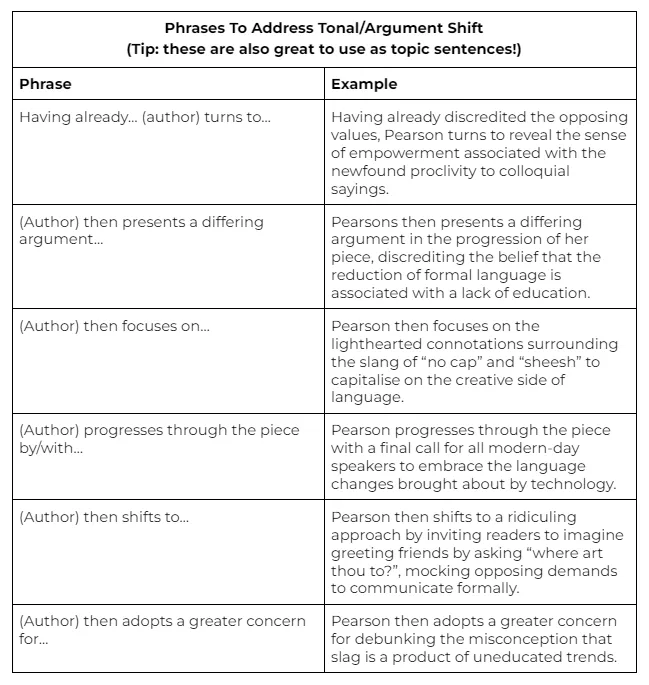

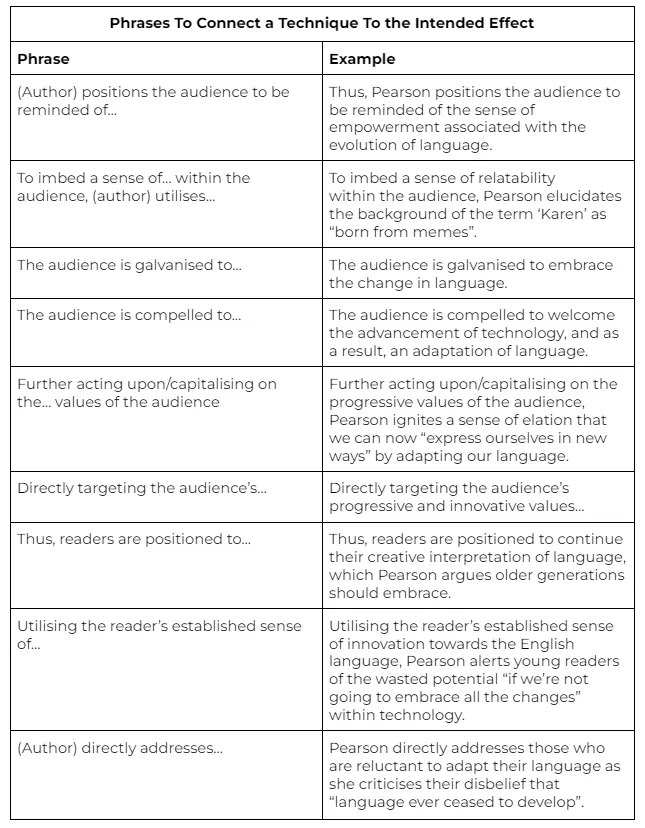
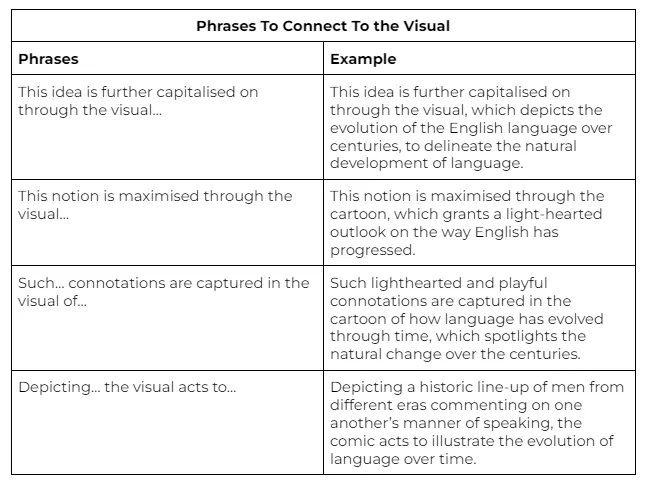
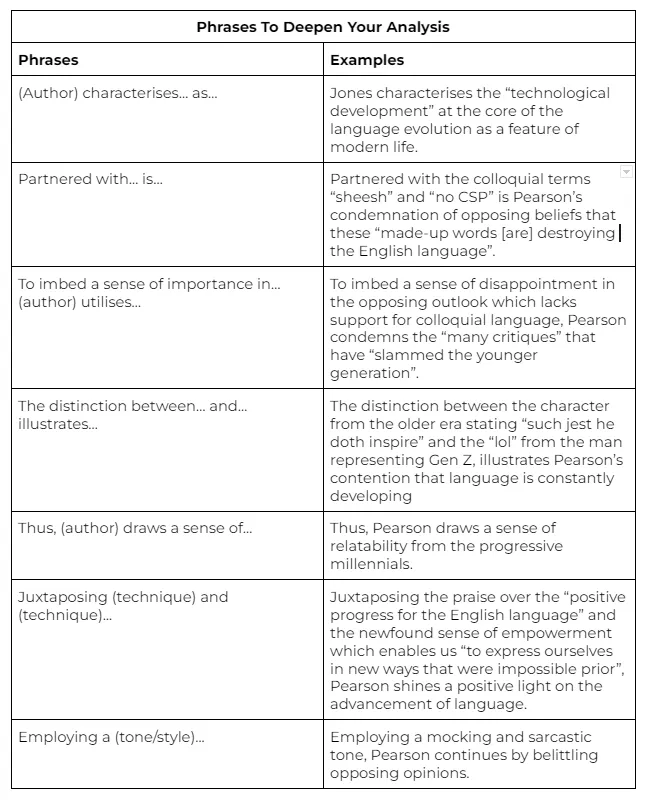




.jpg)